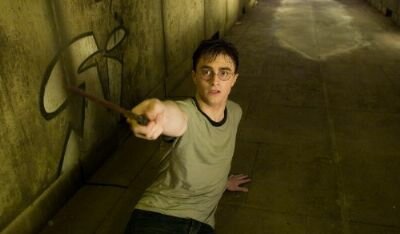From the opening attack of some truly terrifying Dementors through to a nightmarish climax in which one of the leading characters is killed, this is the darkest Harry Potter film so far, and parents of small or nervous children should take note of the 12A certificate.
|
Harry (Daniel Radcliffe, pictured) is first threatened with expulsion from Hogwarts by the officious Cornelius Fudge, Minister of Magic (Robert Hardy), and saved only by the timely intervention of his headmaster, Dumbledore (Michael Gambon). Returning to school, Harry finds himself mistrusted by all the pupils who read the seemingly government-controlled newspaper, the Daily Prophet. The received view among his peers is that he is lying when he says that the dreaded Lord Voldemort (Ralph Fiennes) is back. |
Naturally, Harry’s best friends Ron (Rupert Grint) and Hermione (Emma Watson) stand by him, as do a few others, including the late Cedric Diggory’s ex-girlfriend Cho Chang (Katie Leung), with whom Harry shares his first kiss. “How was it?” asks Ron. “Wet,” answers Harry.
|
The difference between boys and girls is amusingly delineated as Ron admits to being baffled by the complexities of female emotions, and Hermione tells him “You’ve got the emotional range of a teaspoon” – which is probably a bit unfair to teaspoons. |
Teenage hormones are working in other ways as well, and Harry is worried that Voldemort may be taking over his mind: “I’m becoming more like him. I feel so angry, all the time.” |
One of the best things about the film is the way Rowling’s messages – that kindness, friendship and community are great defences against tyranny, and that it is within our own power to withstand our dark side – come across loud and clear in American screenwriter Michael Goldenberg’s cleverly structured screenplay. |
Everything isn’t perfect. Rowling’s books have been getting longer and longer, which has made the task of condensing them to a watchable length in the cinema an increasingly tough assignment. I wrote of the fourth in the series, “The story-telling may be a bit too rushed, and the leaps in the narrative off-putting to those who haven’t read the book.” Those faults are still present in The Order of the Phoenix, and anyone who hasn’t read the novel may find themselves baffled – not so much at what is happening, but at why precisely it is happening. |
So what’s best in Harry Potter 5? For a start, we have one of our finest and funniest actresses as the villainess. Imelda Staunton has a whale of a time as Professor Dolores Umbrage, a stooge of the Ministry of Magic and the latest teacher to hold the poisoned chalice of teaching Defence Against the Dark Arts. With the matronising quality of Patricia Hewitt and the bright-eyed humourlessness of Harriet Harman, Umbrage emerges as the most unpleasant pedagogue to have escaped the pages of a novel since Wackford Squeers. |
Rowling uses the character of Umbrage to satirise our present educational system, and there are few children or parents who won’t bristle at Umbrage’s cheery insistence that education is all about examinations and that everything in the curriculum should be (a) centrally approved, and (b) completely useless. |
There is something thoroughly New Labour in the cheery way she enacts laws without consultation, especially new infringements of civil liberties. There’s also something curiously topical and familiar about the way she is willing to use violence and torture to achieve her ends, and then pretend she hasn’t used them at all. Truly, she is a villainess for our times – and among the most memorable comic characters of this cinematic year.
|
Another treat is Alan Rickman, revelling in his morally ambivalent attitude to Potter, laced with hatred, and yet the only member of staff daring to treat Umbrage with the icy superciliousness she deserves.
|
The fact that the director of Order of the Phoenix, David Yates, has already been signed up to direct the next Harry Potter was a pretty good indication that he has made a terrific job of this one, and so it proves. One reason that the fourth Harry Potter film was a bit better than its predecessors was that director Mike Newell brought more confident performances out of his younger actors, and Yates continues that good work.
|
The only doubt was whether Yates had the visual flair. Fortunately, in his production designer, Stuart Craig, he has a man who has overseen the design of all the previous Harry Potter movies, and happens to be one of the best in the business. Other distinguished credits have included three Oscars for The English Patient, Gandhi and Dangerous Liaisons, and his work here is of similarly high standard.
|
It’s become fashionable to knock J.K. Rowling, but you won’t catch me doing it. She’s flamboyantly imaginative, has a gift for plotting that pleases adults as much as children, and she’s funny. The ability to create a world that millions wish to enter is not to be scorned. And in The Order of the Phoenix, she has some pertinent points to put across about education and good government.
|
Here is a comedy that is free of gross-out humour, and the first adventure blockbuster of this summer in which the special effects illuminate the story, rather than replace it. I enjoyed it a lot, and I believe you will too.
|
|
|
